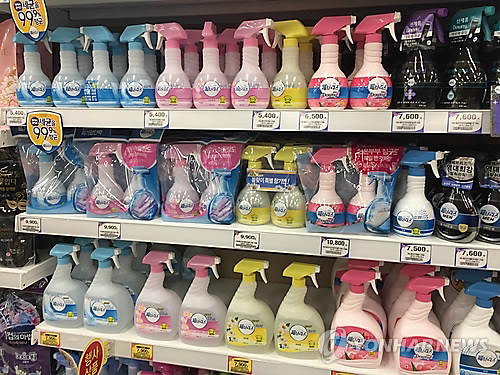Toxic chemical fears shift to other firms
Legal loopholes that do not obligate companies to list ingredients cited as major cause of weak control of chemical goods
By Korea HeraldPublished : May 16, 2016 - 16:26
Amid growing concerns over the health risks of household chemical products, a fresh round of speculation is brewing over other manufacturers of cleaning supplies in Korea that may have been using harmful substances without indicating their toxicity.
The Environment Ministry on Sunday demanded a local branch of global consumer goods company Procter & Gamble release the list of chemical substances used for its fabric refresher Febreze.
The request came after local reports drawing concerns over the use of quaternary ammonium chloride, a type of antimicrobial agent, in its popular fabric refresher.
Some experts say the chemical can damage the lungs if inhaled.
The Environment Ministry on Sunday demanded a local branch of global consumer goods company Procter & Gamble release the list of chemical substances used for its fabric refresher Febreze.
The request came after local reports drawing concerns over the use of quaternary ammonium chloride, a type of antimicrobial agent, in its popular fabric refresher.
Some experts say the chemical can damage the lungs if inhaled.

A public relations representative of P&G Korea acknowledged the use of the chemical compound Monday, but denied reports on its toxicity, saying it had been tested as “safe” in the U.S. and Europe and also in Korea before it hit the local market years ago.
The company said in a separate statement Monday afternoon that it had already submitted a list of all ingredients to the environment ministry and will disclose them this week via the brand’s website.
“P&G Korea has carefully observed the related law so far and disclosed the lists of ingredients as stipulated by the law,” she said.
P&G Korea can claim this is compliant with the law because the company has no legal obligation to publicly release the list of ingredients.
In Korea, it is not mandatory for companies to list all ingredients of households products, if not cosmetics.
Before the government implemented the Chemical Registration and Assessment Act implemented last year, household chemical products like Febreze were even classified as industrial goods that fell under jurisdiction of the Ministry of Trade, Industry and Energy, making it difficult to force products to undergo toxicity tests.
With the introduction of the new law last year, 15 products, including sterilizers, deodorant and air fresheners, came under the control of the environment ministry, said Kim Young-min, an official at the ministry.
“P&G Korea has no legal obligation to reveal the list, but if it doesn’t the ministry will have to seek a court order,” he said in a phone interview, adding that Febreze passed a safety test after the new law was implemented.
Despite the government’s move, fears are growing among customers that Febreze sold in Korea may carry different chemicals to versions sold in other markets.
Experts say that P&G America offers broad information on the products through its websites. But in Korea, the product has nothing but a label indicating it is an antimicrobial agent, they said.
Korean companies are also being targeted for possible use of toxic chemicals in their products.
Newsis, a local news agency, reported Monday that LG Household & Health Care, the nation’s second-largest cosmetics firm, sold humidifier disinfectants that may have carried harmful substances in the late 1990s.
A customer surnamed Kim told the agency that his newborn child was hospitalized with cyanoderma – a discoloration of the skin -- in 1999 during the time the family was using a sterilizer manufactured by LG Chemical, the predecessor of LG H&H before it was spun off. Most of the victims of Oxy Reckitt Benkiser claimed to suffer from cyanoderma as well as difficulty breathing.
After watching Oxy Reckitt Benkiser’s sterilizer being accused of the mysterious deaths of pregnant mothers and babies, Kim told the agency that he came forward thinking his family went through suffering because of the humidifier and the disinfectant product the family used at that time.
Expressing bewilderment, LG H&H told The Korea Herald it had checked the data from its research and the product did not contain any of the four major toxic ingredients -- PHMG, PGH, CMIT and MIT -- that have been linked to killing more than 100 people. The company, however, reiterated its earlier position that it is not considering disclosing the list of chemicals in a product that it stopped selling 15 years ago.
“We are not obliged to open the list. But we have confirmed that the product didn’t contain the four toxic substances,” said Kim Min-jeong, public relations manager of LG Household & Health Care.
“We are confused because we didn’t have any customers complaining about the product in the last 15 years,” she said.
When asked about discontinuing the product in 2001, Kim said the market for humidifier sterilizers was small at that time and it didn’t sell well.
By Cho Chung-un (christory@heraldcorp.com)
Staff reporters Kim Da-sol and Sohn Ji-young contributed to this article. - Ed.
-
Articles by Korea Herald



![[Exclusive] Korean military set to ban iPhones over 'security' concerns](http://res.heraldm.com/phpwas/restmb_idxmake.php?idx=644&simg=/content/image/2024/04/23/20240423050599_0.jpg&u=20240423183955)

![[Graphic News] 77% of young Koreans still financially dependent](http://res.heraldm.com/phpwas/restmb_idxmake.php?idx=644&simg=/content/image/2024/04/22/20240422050762_0.gif&u=)



![[Pressure points] Leggings in public: Fashion statement or social faux pas?](http://res.heraldm.com/phpwas/restmb_idxmake.php?idx=644&simg=/content/image/2024/04/23/20240423050669_0.jpg&u=)










